Hi, I have an amplifier designed by a French manufacturer around the 2000s, this amplifier looks a lot like the
Beard p35mkII,
the output transformers, the same models that integrate the JADIS amplifiers, because the manufacturer was in Toulouse.
I would like to improve this amplifier, if you can help me?
I started by replacing the capacitors that were out, but I think we can do better?
Regards
Gil
Beard p35mkII,
the output transformers, the same models that integrate the JADIS amplifiers, because the manufacturer was in Toulouse.
I would like to improve this amplifier, if you can help me?
I started by replacing the capacitors that were out, but I think we can do better?
Regards
Gil
Attachments
-
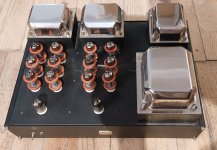 20230515_131258.jpg421.7 KB · Views: 250
20230515_131258.jpg421.7 KB · Views: 250 -
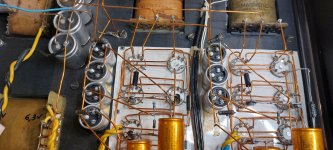 20231106_164951.jpg446.8 KB · Views: 253
20231106_164951.jpg446.8 KB · Views: 253 -
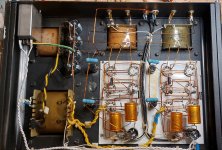 20231110_083243.jpg581.1 KB · Views: 344
20231110_083243.jpg581.1 KB · Views: 344 -
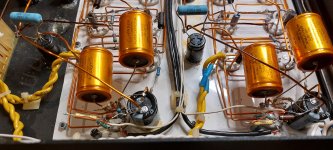 20231110_083255.jpg418.4 KB · Views: 237
20231110_083255.jpg418.4 KB · Views: 237 -
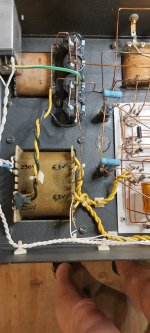 20231110_083302.jpg437.1 KB · Views: 238
20231110_083302.jpg437.1 KB · Views: 238 -
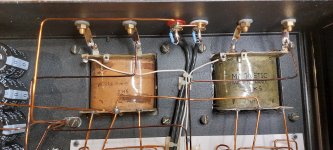 20231110_083308.jpg512.3 KB · Views: 225
20231110_083308.jpg512.3 KB · Views: 225 -
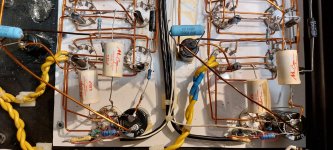 20231114_135230.jpg424.5 KB · Views: 206
20231114_135230.jpg424.5 KB · Views: 206 -
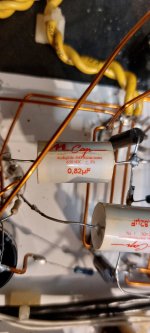 20231114_145611.jpg240.4 KB · Views: 192
20231114_145611.jpg240.4 KB · Views: 192 -
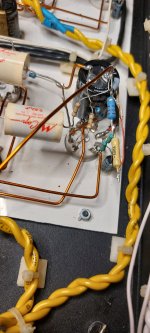 20231115_092146.jpg346.7 KB · Views: 227
20231115_092146.jpg346.7 KB · Views: 227
Last edited by a moderator:
The amp works, it worked for 20 years. However, it broke down due to a weld that had failed, I decided to restore it, but I’m not too familiar with tube amplifiers
Judging by the construction, neither was the builder. 😉but I’m not too familiar with tube amplifiers
jeff
OK, you want the amplifier to operate properly like it did before, Right?
And you want it to be be reliable, Right?
You asked about improving it. Improve the "Sound"?
Like more solid bass, smoother midrange, sweeter highs; willing to give up some of the power out, etc.?
(Have a defined target to hit).
What is your speaker make and model number?
I believe that 'wiring in the air' is called 'Point to Point wiring'.
Many of us still use that, instead of using PCBs, or we use a combination of Both.
And yes, point to point can have the wiring laying right on the chassis, instead of in the air.
Lay a wire on a chassis, and increase the capacitance to ground . . . dramatically.
Always get an amplifier working properly, before modifying it.
Have fun fixing, modifying, and listening.
And you want it to be be reliable, Right?
You asked about improving it. Improve the "Sound"?
Like more solid bass, smoother midrange, sweeter highs; willing to give up some of the power out, etc.?
(Have a defined target to hit).
What is your speaker make and model number?
I believe that 'wiring in the air' is called 'Point to Point wiring'.
Many of us still use that, instead of using PCBs, or we use a combination of Both.
And yes, point to point can have the wiring laying right on the chassis, instead of in the air.
Lay a wire on a chassis, and increase the capacitance to ground . . . dramatically.
Always get an amplifier working properly, before modifying it.
Have fun fixing, modifying, and listening.
My approach is to draw the schematic in LTSpice, then try and get a simulation going. That way you have a way to evaluate changes and check operating points without changing the original circuit. It doesn't have to be a perfect simulation with OPTs, etc, just good enough so that voltage measurements tally OK.
Personally I think the original constructor DID know what they were doing. Looks like a nice build to me. Maybe some shrinkwrap or insulation would have been a good idea on the non-ground wiring.
Personally I think the original constructor DID know what they were doing. Looks like a nice build to me. Maybe some shrinkwrap or insulation would have been a good idea on the non-ground wiring.
Hello, thank you for your answers, I wanted to know if I can apply the same components (resistor and capacitors) as the BEARDP35 on this amplifier? , as they are very similar, the output transformers are 3.5k
Just draw the schematic first, as suggested by @OldHector, even in a piece of paper. Then we can compare it with the BEARDP35.I wanted to know if I can apply the same components (resistor and capacitors) as the BEARDP35 on this amplifier?
If you just treat LTspice as a useful tool for drawing a schematic, it is very powerful at doing that, but maybe a bit counterintuitive for those of use that only live in a Microsoft bubble. If you make the ASC file from LTSpice available here then most here can turn it into a simulation in a short time. Plus you have a nice drawing!
- Home
- Amplifiers
- Tubes / Valves
- Beard P35